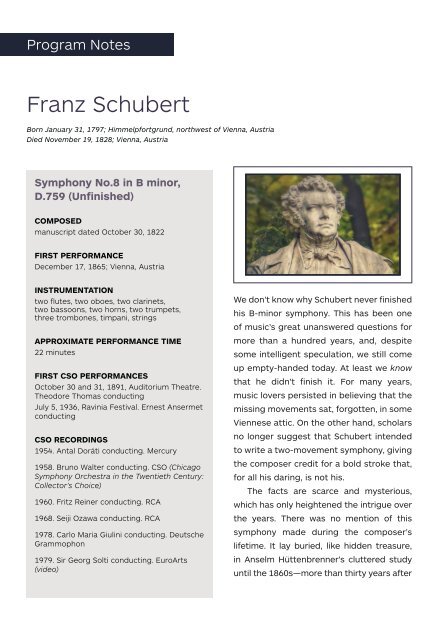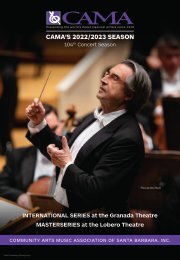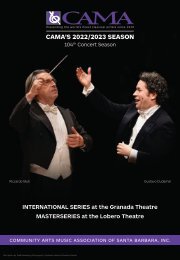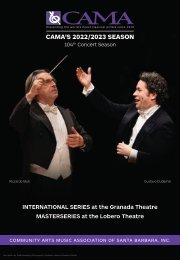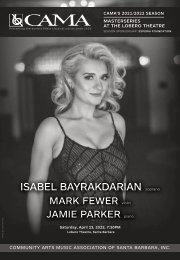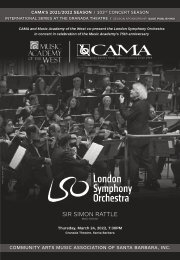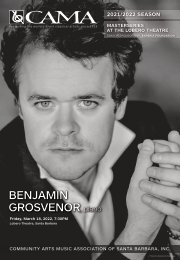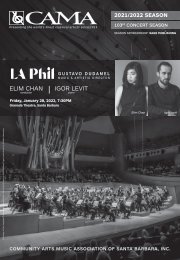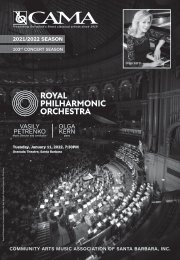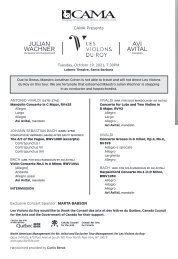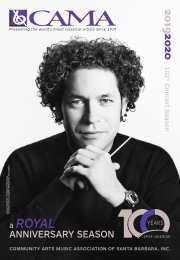CAMA presents Chicago Symphony Orchestra - October 21, 2017 - International Series at The Granada Theatre
Chicago Symphony Orchestra Saturday, October 21, 2017, The Granada Theatre, 8pm Riccardo Muti Music Director Stephen Williamson Clarinet Franz Schubert: Symphony No.8, D.759, “Unfinished” Wolfgang Amadeus Mozart: Clarinet Concerto in A Major, K.622 Robert Schumann: Symphony No.2 in C Major, Op.61 Not seen in Santa Barbara since 1987, the Chicago Symphony Orchestra is consistently hailed as one of the greatest orchestras in the world. In collaboration with the best conductors and guest artists on the international music scene, the CSO performs well over one hundred concerts each year at its downtown home, Symphony Center and at the Ravinia Festival on Chicago’s North Shore. Music lovers outside Chicago enjoy the sounds of the Chicago Symphony Orchestra through best-selling recordings and sold-out tour performances in the United States and around the globe. Maestro Riccardo Muti is one of the preeminent conductors of our day. In 2010, when he became the tenth music director of the Chicago Symphony Orchestra (CSO), he already had more than forty years of experience at the helm of the Maggio Musicale Fiorentino, Philharmonia Orchestra, Philadelphia Orchestra, and Teatro alla Scala.
Chicago Symphony Orchestra
Saturday, October 21, 2017, The Granada Theatre, 8pm
Riccardo Muti Music Director
Stephen Williamson Clarinet
Franz Schubert: Symphony No.8, D.759, “Unfinished”
Wolfgang Amadeus Mozart: Clarinet Concerto in A Major, K.622
Robert Schumann: Symphony No.2 in C Major, Op.61
Not seen in Santa Barbara since 1987, the Chicago Symphony Orchestra is consistently hailed as one of the greatest orchestras in the world. In collaboration with the best conductors and guest artists on the international music scene, the CSO performs well over one hundred concerts each year at its downtown home, Symphony Center and at the Ravinia Festival on Chicago’s North Shore. Music lovers outside Chicago enjoy the sounds of the Chicago Symphony Orchestra through best-selling recordings and sold-out tour performances in the United States and around the globe. Maestro Riccardo Muti is one of the preeminent conductors of our day. In 2010, when he became the tenth music director of the Chicago Symphony Orchestra (CSO), he already had more than forty years of experience at the helm of the Maggio Musicale Fiorentino, Philharmonia Orchestra, Philadelphia Orchestra, and Teatro alla Scala.
You also want an ePaper? Increase the reach of your titles
YUMPU automatically turns print PDFs into web optimized ePapers that Google loves.
Program Notes<br />
Franz Schubert<br />
Born January 31, 1797; Himmelpfortgrund, northwest of Vienna, Austria<br />
Died November 19, 1828; Vienna, Austria<br />
<strong>Symphony</strong> No.8 in B minor,<br />
D.759 (Unfinished)<br />
COMPOSED<br />
manuscript d<strong>at</strong>ed <strong>October</strong> 30, 1822<br />
FIRST PERFORMANCE<br />
December 17, 1865; Vienna, Austria<br />
INSTRUMENTATION<br />
two flutes, two oboes, two clarinets,<br />
two bassoons, two horns, two trumpets,<br />
three trombones, timpani, strings<br />
APPROXIMATE PERFORMANCE TIME<br />
22 minutes<br />
FIRST CSO PERFORMANCES<br />
<strong>October</strong> 30 and 31, 1891, Auditorium <strong>The</strong><strong>at</strong>re.<br />
<strong>The</strong>odore Thomas conducting<br />
July 5, 1936, Ravinia Festival. Ernest Ansermet<br />
conducting<br />
CSO RECORDINGS<br />
1954. Antal Doráti conducting. Mercury<br />
1958. Bruno Walter conducting. CSO (<strong>Chicago</strong><br />
<strong>Symphony</strong> <strong>Orchestra</strong> in the Twentieth Century:<br />
Collector’s Choice)<br />
1960. Fritz Reiner conducting. RCA<br />
1968. Seiji Ozawa conducting. RCA<br />
1978. Carlo Maria Giulini conducting. Deutsche<br />
Grammophon<br />
1979. Sir Georg Solti conducting. EuroArts<br />
(video)<br />
We don’t know why Schubert never finished<br />
his B-minor symphony. This has been one<br />
of music’s gre<strong>at</strong> unanswered questions for<br />
more than a hundred years, and, despite<br />
some intelligent specul<strong>at</strong>ion, we still come<br />
up empty-handed today. At least we know<br />
th<strong>at</strong> he didn’t finish it. For many years,<br />
music lovers persisted in believing th<strong>at</strong> the<br />
missing movements s<strong>at</strong>, forgotten, in some<br />
Viennese <strong>at</strong>tic. On the other hand, scholars<br />
no longer suggest th<strong>at</strong> Schubert intended<br />
to write a two-movement symphony, giving<br />
the composer credit for a bold stroke th<strong>at</strong>,<br />
for all his daring, is not his.<br />
<strong>The</strong> facts are scarce and mysterious,<br />
which has only heightened the intrigue over<br />
the years. <strong>The</strong>re was no mention of this<br />
symphony made during the composer’s<br />
lifetime. It lay buried, like hidden treasure,<br />
in Anselm Hüttenbrenner’s cluttered study<br />
until the 1860s—more than thirty years after


